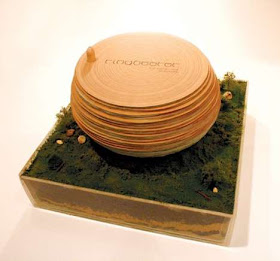Age appears to be best in four things: old wood to burn,
old wine to drink, old friends to trust, and old authors to read.
Francis Bacon (paraphrasing Athenaeus)
 |
| Close-up of paper made from spruce, poplar, pine, and fir trees. Image courtesy of Science Photo Library. |
Well, let's not burn all the wood. Yet. Let's look at the connection between wood and what old authors wrote to read: books. Specifically, books made of paper made of wood. The Arabs were the first to produce paper books in the 8th century after learning papermaking from the Chinese. Europeans used paper made of rag until about 150 years ago, when it became standard to print books on paper made of wood.
 |
| Front and rear of a piece of birch bark. Image courtesy of Wikipedia. |
From an etymological standpoint, "book" and "beech" are related. The Germanic root of both words is *bk- from an Indo-European root which means "beech tree"; the Old English form of book is bc, from the Germanic *bk-, and it meant "book, or a written document". This makes sense when you consider that the early Germanic people used strips of beech to write on.
The early Romans also used the smooth inner lining of a tree to write on. Their word for it, which literally means "bark", is liber, which came to be the word for book, and eventually library. Likewise the Latin word for codex, comes from caudex which means a tree trunk.
The relationship between books and wood is obvious, so news of books made of wood doesn’t seem so extraordinary. But there are fifty-six of them that are quite exceptional. These books are kept by the Orto Botanico di Padova.
The University of Padua, founded in 1222, is famous for many things and an all-star cast of alumni. But another stellar thing they are famous for is their wooden books. These books are about trees, and also made of trees. There is a different specie of tree in each book. The covers were made of a piece of wood from its respective tree showing radial, longitudinal, and cross profiles. On each spine is a sample of the bark from that tree.
Inside the books are parts of the tree: seeds, seedlings, flowers, leaves, roots, sawdust, charcoal, and ash. Each is fastened to the insides and numbered. Also inside are pieces of parchment with a handwritten legend identifying the samples.
These were created in the late 1700s or early 1800s, and there once was about one hundred of them. Unfortunately so many have been lost or destroyed that only fifty-six of them remain. Those that are extant are a much better way of recording information about their respective trees than drawings or written accounts, because the items saved serve as DNA blueprints.
If you really love wood, no doubt you are familiar with your local xylarium. But if there isn’t one near you, don’t despair. The World Woods Library is an ongoing project of wooden books made from woods from all over the world. Choose your favorite tree, then buy the book:
Graphic designer Jason Arias made up a typeface design called Ringbearer, that was influenced by tree rings. He decided to make a book for the typeface, made of actual tree rings from a tree trunk. Each round "sheet" bears a letter of the font, other information about the project, and at the bottom is a niche that holds a folded poster that shows all the characters.
Not content to stick with the innovation of the somewhat eponymous book, Arias also redesigned a magazine cover using his font:
So before you chuck another log on the fire, think about what else you could do with it. The mind you save could be your own.
*******************************














I love this!
ReplyDeleteThat's because you are an artiste, Ellen!
ReplyDeleteThis is wonderfuly fascinating. I love trees. I write about trees, I decorate drees, I draw and paint images of trees, and I plant trees on my property. So, of course, I own many books about trees, but not some of these.
ReplyDeleteI found your blog while doing an image search for wood books. I used your image in my own blog post. I hope it really is a Creative Commons photo. I gave your blog photo dredit on mine.